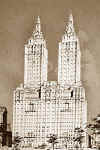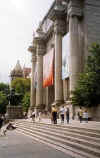new york architecture walks- Upper West Side

|
Dakota Apartments 1 West 72nd Street, Henry Hardenbergh [1881-84] |

|
Langham Buildin |

|
San Remo Apartments 145-146 Central Park West, Emery Roth [1930] |

|
The Kenilworth 151 Central Park West, Ralph Townsend, Steinle and Haskell, 1908 |

|
Universalist Church of New York` 4 West 76th Street, William Potter [1898] |

|
New York Historical Society 170 Central Park West, York and Sawyer [1908] and Walker and Gillette [1938] |

|
American Museum of Natural History |

|
The Studio Building 44 West 77th Street, Harde and Short [1909] |

|
Ansonia Hotel 2109 Broadway, Graves and Duboy [1899-1904] |

|
Row Houses 341-357 West End Avenue, Lamb and Rich [1890-91] |

|
West End Collegiate Church West End Avenue at 77th Street, Robert Gibson [1891-2] |

|
Row Houses 301-307 West 78th Street, Frederick B. White [1884-6] |

|
Apthorp Apartments 2111 Broadway, Clinton and Russell [1906-8] |
| The Upper West Side became the city's new residential quarter in late 19th and early 20th Century. Mostly, these homes were built for residents who worked downtown. The new elevated lines of the 1870s made it possible to develop this barren, rocky terrain into blocks of row houses, tenements and apartment houses for the very wealthy and for the working middle-class. The city's new quarter quickly attracted many established religious institutions that built grand buildings on important corner lots in an effort to outshine one another. Cultural institutions also blossomed in this new, elite section of the city. This walk will focus on different housing types, and the development of the multiple-dwelling building, from the tenement to the grand apartment house. |
